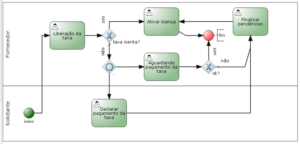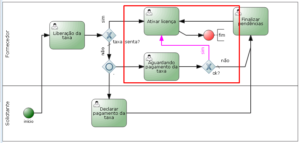To solve a problem it is necessary to identify its root cause. As this is mostly unknown, there are several techniques, methodologies, or tools – depending on the problem – that can help in this task. One of them is MASP, acronym for Methodology for Analyzing and Solving Problems. As the name suggests, this is a methodology that assists in identifying and solving problems.
Like PDCA (we talked about it in this article), MASP is also a continuous improvement tool. The method consists of eight specific steps, namely: problem identification, observation, analysis, action plan, action, verification, standardization, and conclusion.
To make the understanding of each step clear, we will present below a problem based on and adapted from a real event, and in which it was possible to apply the methodology.
Model problem

The image above demonstrates the flowchart of how a software license purchase process works. The process is started by the requestor and then the vendor releases a fee. Software license activation can occur in three scenarios:
- The requestor is exempt from fee;
- The payment of the fee is recognized by the system in the “Awaiting payment of the fee” phase;
- The requestor declares that the payment has already been made and has a voucher in the “Declare fee payment” phase before the system recognizes the payment. If the requestor tries to prove that the payment was made with a false document, the system suspends the purchase request. Thus, it is only released if the requestor makes the payment through the bank and the system recognizes this payment.
Applying the MASP methodology
Using the above problem as an example, we will apply the MASP methodology in the steps described in the introduction:
Step 1: Identification of the problem
Occasionally, there were requests in which the activation of the registration was not performed even after the fee had been paid by the requestor. The problem was classified as critical, as it involved money and prevented the requestor from using what he paid for.
The risk that the problem presented was to lose the reputation of the product and the company, and to be indicted in a court case.
Step 2: Problem observation
After observing the problem from various angles using the questions below, we identified something in common between requests. In all of them the requestor had performed the task “Declare payment of the fee” with a false document.
Following the flow of the license purchase process, the system suspended the request. The requestor then made the payment through the bank, which was recognized by the system. However, the license was not activated.
Questions that should be asked in this step:
- How often do results vary?
- Are results different in different locations?
- Do results vary with a particular user?
- How do results vary?
Step 3: Problem analysis
Based on the observation made in the previous step of MASP, we chose the most likely causes for our problem. This way, the professionals who had greater participation in the creation of the license activation process to assist in this stage were gathered.
Possible causes that have been raised:
- Inconsistency in the fee payment recognition system;
- Inconsistency in the way the license purchase process was developed;
- Momentary intermittence of the entire system.
Step 4: Definition of action plans
Plans were drawn up to block the causes raised in the previous step, so that the root cause of the initial problem could be identified through elimination. It is important to check the possible consequences of the action plans and how effective they are, otherwise they will generate a new problem and that will be a tremendous headache.
Action plans for the possible causes raised in step 3:
- Monitoring of the system that performs the fee payment recognition through logs – data collected from the system to verify that it is behaving as it should;
- Brainstorming with the professionals who participated in the creation of the license purchase process;
- Monitoring the entire system – the system that encompasses the various types of processes, from the license purchase request to the CD purchase request, for example – through tools such as Java Mission Control, a tool that allows the collection and analysis of data from applications developed in JAVA language.
Step 5: Execution of actions
For the fifth step of MASP, choose the most appropriate professionals to execute the action plans and collect the results. The monitoring pointed out in the previous step was performed daily – once a day – since the average time between the acknowledgement of the fee payment and the activation of the license was more than a day, and the brainstorm was performed in a single day.
Step 6: Verification of results
With the results collected in the previous step, compare whether the problem was solved, list whether there were positive or negative effects. If there were negative effects, then it is necessary to return to step 3, because it means that the proposed solution has possible flaws.
In the model problem, after performing the actions it was identified that the problem was in the way the license purchase process was developed. It was a scenario not foreseen by the system and with that the license purchase process was changed.
In short, the process was adapted to meet the cases where the system suspended the request and then acknowledged the payment of the fee. See the following image and compare it with the image above.

Step 7: Standardization of the procedure
If the problem was solved, standardize everything that had been raised up to this point, as this will prevent the problem from reoccurring.
Step 8: Conclusion
Evaluate all the steps that were taken so far, as there may be patterns or solutions that can be applied to future events.
Conclusion
A problem is defined as an exercise that requires great effort and determination to be solved. Problems exist in any scope of our reality, and in the professional area it is crucial that they are solved accurately and efficiently, because more unwanted than dealing with a problem is dealing with the same problem more than once.
Try it for 15 days free right now! Or, if you prefer, request a demonstration from our consultants. Count on us to answer all your doubts and help your company!



